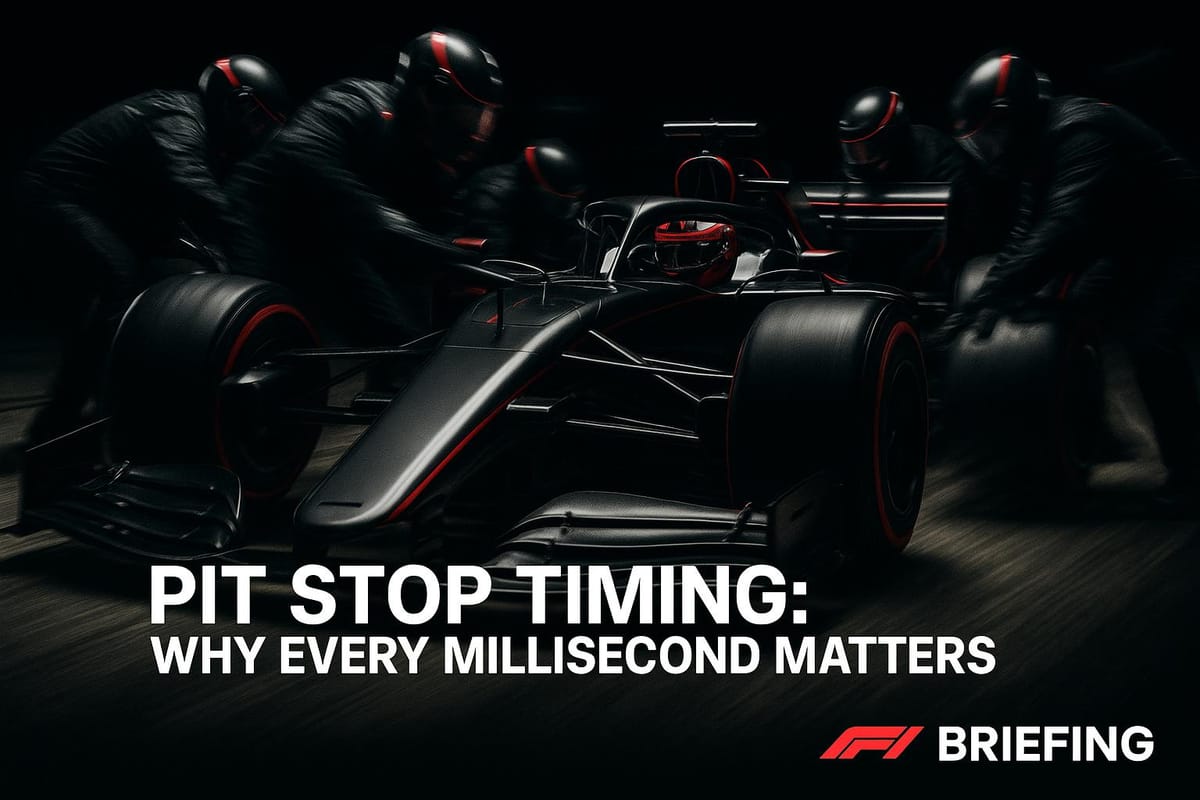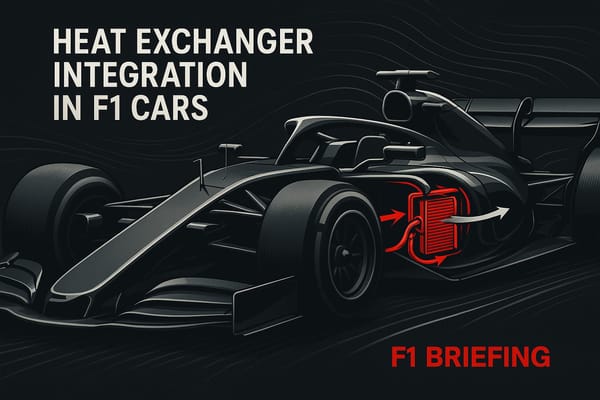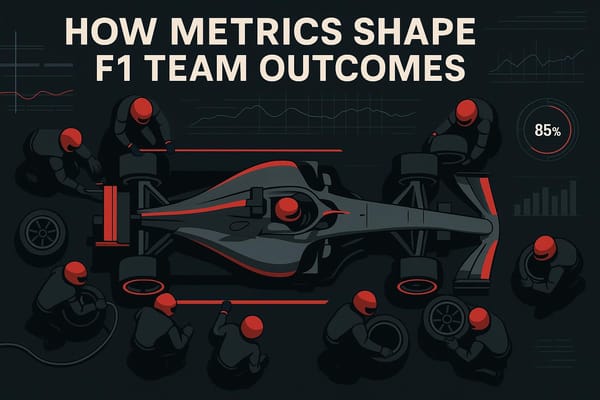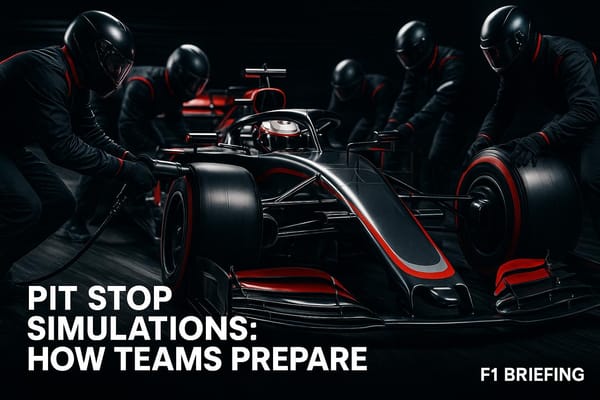Pit Stop Timing: Why Every Millisecond Matters
In Formula 1, every millisecond during pit stops can drastically alter race outcomes, balancing speed and reliability is crucial for success.

In Formula 1, pit stops are more than just a quick tire change - they can decide the outcome of a race. A delay of even a few milliseconds can mean losing track position or missing a podium finish. Teams like Ferrari and McLaren have shown how fast, consistent pit stops can create an edge, while mistakes can derail strategies and confidence.
Key takeaways:
- Fast pit stops (e.g., Ferrari's 2.44-second average) help teams maintain position and execute bold strategies like undercuts.
- Slow stops (e.g., Haas and Williams averaging 3.05 seconds) often lead to lost positions and reactive strategies.
- Success depends on teamwork, precision, and reliable equipment, but pushing for speed increases risks like penalties or mechanical failures.
- Teams must balance speed with consistency to maximize race and championship performance.
Every second counts in Formula 1, and pit stops are where races can be won or lost.
1. Fast Pit Stops
Race Outcome Impact
Quick pit stops are a game-changer in Formula 1, cutting down stationary time and giving drivers a chance to gain or hold onto track position. Take Ferrari's performance in 2025 as an example: they nailed 2.00-second stops at both the Monaco and Saudi Arabian Grands Prix, proving how precision timing can translate to on-track success. Over the first 18 races, Ferrari averaged a pit stop time of 2.44 seconds, which gave them a solid 0.22-second edge over Racing Bulls. On circuits like Monaco or Hungary, where overtaking is notoriously tough, even a fraction of a second can decide whether a driver comes out ahead or falls behind after a pit cycle.
McLaren took it one step further, clocking the season's fastest pit stop at just 1.91 seconds during the Italian Grand Prix, which earned them the DHL Fastest Pit Stop Award for that race. Predictive data for the 2025 season showed a 22.6% chance of pit stops under 1.9 seconds and a 61.6% likelihood of stops faster than 1.91 seconds. These numbers highlight how crucial speed is in giving teams a measurable edge during races.
Fast pit stops aren’t just about saving time - they directly influence how teams approach race strategies.
Team Strategy Implications
When teams can count on lightning-fast pit stops, they gain the freedom to adopt bolder, more adaptable race strategies. A reliable pit crew allows teams to pick the ideal pit windows without worrying about losing track position. This flexibility is especially valuable during unpredictable moments like safety car periods, enabling teams to respond dynamically to changing race conditions. For drivers, knowing their crew can deliver builds confidence, while rival teams may feel the pressure to play it safe. Ferrari’s dominance between rounds 12 and 18 is a testament to how consistent speed in the pits can drive success.
But it’s not just about being fast - it’s about being consistent. Racing Bulls exemplified this by maintaining a 0.05-second advantage per stop over their sister team, Red Bull. Their ability to avoid costly errors highlighted the importance of steady performance alongside raw speed.
Achieving this balance requires a combination of advanced technology and flawless teamwork.
Technological and Execution Factors
Modern Formula 1 pit stops are a masterclass in precision and coordination. High-speed tools, lightweight materials, and rigorous crew training all contribute to shaving off those critical milliseconds. Each team member has a specific role, and perfect synchronization is the name of the game.
Data analysis is another key piece of the puzzle. Teams use high-speed cameras and telemetry to dissect every detail of their pit stops, constantly identifying areas for improvement. However, the pursuit of speed comes with risks - loose wheels, unsafe releases, or penalties can easily derail a race. Success lies in striking a balance between raw speed and error-free execution.
McLaren’s 2025 season underscores this challenge. Despite achieving the season’s fastest stop at 1.91 seconds and several sub-2-second performances, their average pit stop time slipped from 2.89 seconds at round 12 to 2.99 seconds by round 18. This inconsistency ultimately cost them, dropping the team to 8th place in the standings.
2. Slow Pit Stops
Race Outcome Impact
Slow pit stops can completely derail a team's race. In Formula 1's ultra-competitive environment, even a fraction of a second can determine whether a team secures points or slides down the order.
The 2025 season showcased just how costly these delays can be. Haas and Williams, for instance, averaged 3.05 seconds per stop - 0.61 seconds slower than Ferrari's 2.44-second average. While this gap might seem minor, in Formula 1, where every split-second counts, it can make or break a race.
Racing Bulls experienced this harsh reality during the Dutch Grand Prix at Zandvoort. A single 6.7-second stop cost them a potential podium finish. Equipment failures, like faulty wheel guns or stuck wheel nuts, can turn a routine pit stop into a disaster, highlighting the immense pressure teams face during every race.
These lost seconds force teams to rethink their strategies on the fly, often leading to high-stakes decisions.
Team Strategy Implications
When pit stops go wrong, teams are forced into damage control. They must quickly adjust fuel loads, tire strategies, and pit windows to recover lost time. This reactive approach often pushes teams into riskier territory as they scramble to regain their footing.
The impact isn't just tactical - it can also affect driver confidence. If a driver starts doubting their pit crew’s reliability, they may become more hesitant on track. The midfield battle is especially intense; the bottom five teams in pit stop performance - Aston Martin, Alpine, McLaren, Haas, and Williams - are separated by less than a tenth of a second in average stop times. For these teams, even minor improvements in pit stop consistency can lead to meaningful gains in the championship standings.
But strategy adjustments are only part of the story. The root of slow stops often lies in mechanical and execution issues.
Technological and Execution Factors
In a sport where milliseconds matter, mechanical failures can ruin even the best-laid plans. Faulty wheel guns, stuck wheel nuts, and miscommunication within the pit crew are common culprits. Even teams with cutting-edge equipment aren't immune to these pitfalls.
The reliability of pit stop gear is crucial for maintaining consistency. Teams pour resources into backup systems and regular maintenance, but unexpected failures can still strike at the worst possible moments. Racing Bulls' technical mishap at Zandvoort is a stark reminder that even the most prepared teams can be caught off guard.
To combat these issues, teams rely heavily on data analytics. High-speed cameras and telemetry help dissect every aspect of a pit stop, allowing teams to identify inefficiencies and refine their processes. Equally important are rigorous training sessions and seamless crew coordination. The difference between top-performing teams and those struggling often boils down to how well - and how often - they practice.
Weather adds yet another layer of complexity. Wet conditions, in particular, make tire changes trickier and can expose weaknesses in both equipment and crew execution. In such scenarios, well-prepared teams tend to outshine those still grappling with consistency, widening the performance gap further.
F1's Pit Stop Time Loss Explained
Advantages and Disadvantages
In Formula 1, the decision to prioritize speed or reliability during pit stops is a delicate balancing act. This choice can significantly shape race outcomes, as each approach comes with its own set of benefits and challenges.
| Aspect | Fast Pit Stops | Slow Pit Stops |
|---|---|---|
| Primary Advantage | Maintains track position and competitive edge | Reduces mechanical errors and improves stability |
| Time Impact | Potentially saves valuable seconds | Takes longer but avoids costly mistakes |
| Strategic Benefit | Enables aggressive strategies like undercuts | Encourages a safer, more controlled approach |
| Risk Level | High precision required; minimal margin for error | Lower immediate risk, though time losses can add up |
| Equipment Demands | Relies on advanced tools and flawless execution | Focuses on durable equipment and consistent processes |
| Crew Pressure | Demands intense focus and extensive training | Emphasizes steady performance under lower pressure |
| Championship Impact | Can secure crucial advantages in tight races | Risks gradual losses in position over a season |
Fast pit stops are a hallmark of aggressive racing strategies. By minimizing pit lane time, teams can seize opportunities to undercut rivals and maintain momentum on the track. A quick, efficient stop not only boosts the driver's confidence but also enhances the team's strategic flexibility during the race. However, this pursuit of speed comes with considerable risks. A single misstep - whether it’s a miscommunication or a hardware issue - can lead to disastrous consequences like unsafe releases or damaged car components.
On the other hand, slower pit stops prioritize stability and reduce the likelihood of errors. This approach ensures consistent performance across race weekends and minimizes mechanical issues. For teams battling in the midfield or lower, avoiding mistakes may outweigh the importance of saving fractions of a second. The trade-off, however, is the potential loss of track position. Over the course of a race, these incremental time losses can add up, undermining strong qualifying performances or well-planned strategies.
In adverse conditions, teams that focus on reliability often find themselves better equipped to handle challenges. For teams with tighter budgets, allocating resources to car development rather than shaving milliseconds off pit stops might prove more beneficial in the long run. This method allows them to maximize overall performance without overextending their capabilities.
Ultimately, the choice between speed and reliability depends on a team’s goals and resources. Top teams vying for championships typically cannot afford slower stops, as every second counts in the fight for victory. Meanwhile, teams further down the grid must carefully assess whether the risks of rapid pit stops are worth the potential rewards. Striking the right balance is critical, as pit stop strategies can often define a team’s success over the course of a season.
Conclusion
In Formula 1, every millisecond during a pit stop can make or break a driver's race. A fraction of a second might mean the difference between maintaining track position or losing it. Teams must strike a delicate balance between speed and reliability, as both fast and calculated stops offer unique strategic advantages.
Quick stops are crucial for moves like the undercut or holding onto track position, but they leave no room for mistakes. On the other hand, slightly slower, more deliberate stops reduce the likelihood of errors but can sacrifice valuable time on the track. The best teams know how to adapt, using a mix of these approaches based on race conditions, championship goals, and their own capabilities.
For top-tier teams chasing wins, speed is often the priority. Meanwhile, midfield teams may focus on consistency and avoiding costly errors. Ultimately, pit stop strategies must align with a team's resources, strengths, and race-day objectives.
Today’s F1 pit stops are a symphony of advanced technology, rigorous crew training, and seamless teamwork - all working together to save precious milliseconds. It’s a reminder that in this sport, every split-second truly matters.
To explore more about pit stop strategies and race-day tactics, check out F1 Briefing.
FAQs
How do Formula 1 teams maintain precision and avoid mistakes during rapid pit stops?
Formula 1 teams pull off lightning-fast pit stops by combining rigorous preparation, seamless teamwork, and cutting-edge technology. Each crew member has a clearly defined role, and teams rehearse these high-stress scenarios repeatedly to fine-tune their timing and coordination.
Advanced tools and real-time data analysis are also key players in this process. From tracking tire temperatures to determining the exact second to release the car, every aspect is carefully monitored and controlled. This attention to detail allows teams to complete pit stops in mere seconds, maintaining precision and avoiding costly mistakes. It's this blend of practice, expertise, and innovation that keeps performance steady during the heat of the race.
How does technology help Formula 1 teams achieve faster pit stops?
Technology has become a game-changer in making Formula 1 pit stops faster and more accurate. Teams rely on cutting-edge tools like pneumatic wheel guns and lightweight titanium wheel nuts to swap out tires in less than two seconds. AI systems and sensors take it a step further, analyzing crew movements in real-time to minimize mistakes and ensure everything runs like clockwork. These advancements have turned pit stops into a high-precision operation, where even the smallest fraction of a second can determine the race's outcome.
Why do some F1 teams choose reliability over speed during pit stops?
Some Formula 1 teams choose to prioritize pit stop reliability over sheer speed, aiming to minimize the risk of costly mistakes during high-pressure moments. Errors such as loose wheels or equipment failures can result in severe time losses, penalties, or even force a car to retire from the race. By emphasizing consistency, teams ensure their pit stops are executed smoothly, helping them stay competitive.
Race strategies also hinge on variables like tire degradation, track conditions, and the timing of the stop within the race. A dependable pit stop plays a crucial role in supporting these strategies, allowing teams to maintain peak performance while avoiding unnecessary risks that could compromise their race results.




